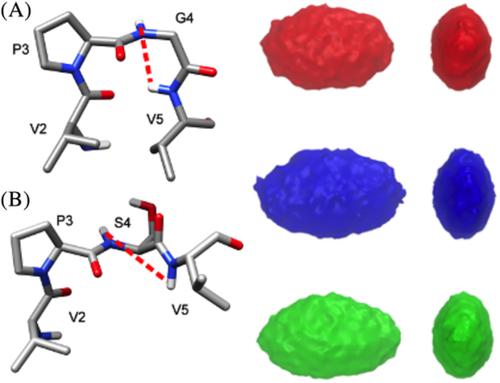当前位置:
X-MOL 学术
›
Biopolymers
›
论文详情
Our official English website, www.x-mol.net, welcomes your feedback! (Note: you will need to create a separate account there.)
The evolutionary background and functional consequences of the rs2071307 polymorphism in human tropoelastin
Biopolymers ( IF 2.9 ) Pub Date : 2020-12-22 , DOI: 10.1002/bip.23414 Sean E Reichheld 1 , Lisa D Muiznieks 1, 2 , Quang Huynh 1 , Nick Wang 1, 3 , Christopher Ing 1, 4 , Ming Miao 1 , Eva E Sitarz 1 , Régis Pomès 1, 5 , Simon Sharpe 1, 5 , Fred W Keeley 1, 5
Biopolymers ( IF 2.9 ) Pub Date : 2020-12-22 , DOI: 10.1002/bip.23414 Sean E Reichheld 1 , Lisa D Muiznieks 1, 2 , Quang Huynh 1 , Nick Wang 1, 3 , Christopher Ing 1, 4 , Ming Miao 1 , Eva E Sitarz 1 , Régis Pomès 1, 5 , Simon Sharpe 1, 5 , Fred W Keeley 1, 5
Affiliation

|
Elastin is a major polymeric protein of the extracellular matrix, providing critical properties of extensibility and elastic recoil. The rs2071307 genomic polymorphism, resulting in the substitution of a serine for a glycine residue in a VPG motif in tropoelastin, has an unusually high minor allele frequency in humans. A consequence of such allelic heterozygosity would be the presence of a heterogeneous elastin polymer in up to 50% of the population, a situation which appears to be unique to Homo sapiens. VPG motifs are extremely common in hydrophobic domains of tropoelastins and are the sites of transient β-turns that are essential for maintaining the conformational flexibility required for its function as an entropic elastomer. Earlier data demonstrated that single amino acid substitutions in tropoelastin can have functional consequences for polymeric elastin, particularly when present in mixed polymers. Here, using NMR and molecular dynamics approaches, we show the rs2071307 polymorphism reduces local propensity for β-turn formation, with a consequent increase in polypeptide hydration and an expansion of the conformational ensemble manifested as an increased hydrodynamic radius, radius of gyration and asphericity. Furthermore, this substitution affects functional properties of polymeric elastin, particularly in heterogeneous polymers mimicking allelic heterozygosity. We discuss whether such effects, together with the unusually high minor allele frequency of the polymorphism, could imply some some evolutionary advantage for the heterozygous state.
中文翻译:

人类弹性蛋白原 rs2071307 多态性的进化背景和功能后果
弹性蛋白是细胞外基质的主要聚合蛋白,提供可扩展性和弹性回缩的关键特性。rs2071307 基因组多态性导致在原弹性蛋白的 VPG 基序中用丝氨酸替换甘氨酸残基,在人类中具有异常高的次要等位基因频率。这种等位基因杂合性的结果是在多达 50% 的人群中存在异质弹性蛋白聚合物,这种情况似乎是智人独有的。VPG 基序在原弹性蛋白的疏水域中极为常见,并且是瞬态 β-转角的位点,对于维持其作为熵弹性体功能所需的构象灵活性至关重要。较早的数据表明,原弹性蛋白中的单个氨基酸取代会对聚合弹性蛋白产生功能影响,特别是当存在于混合聚合物中时。在这里,使用 NMR 和分子动力学方法,我们显示 rs2071307 多态性降低了 β-转角形成的局部倾向,随之而来的是多肽水合的增加和构象集合的扩展,表现为流体动力学半径、回转半径和非球面度的增加。此外,这种取代会影响聚合弹性蛋白的功能特性,特别是在模拟等位基因杂合性的异质聚合物中。我们讨论了这种效应以及多态性异常高的次要等位基因频率是否意味着杂合状态的一些进化优势。特别是存在于混合聚合物中时。在这里,使用 NMR 和分子动力学方法,我们显示 rs2071307 多态性降低了 β-转角形成的局部倾向,随之而来的是多肽水合的增加和构象集合的扩展,表现为流体动力学半径、回转半径和非球面度的增加。此外,这种取代会影响聚合弹性蛋白的功能特性,特别是在模拟等位基因杂合性的异质聚合物中。我们讨论了这种效应以及多态性异常高的次要等位基因频率是否意味着杂合状态的一些进化优势。特别是存在于混合聚合物中时。在这里,使用 NMR 和分子动力学方法,我们显示 rs2071307 多态性降低了 β-转角形成的局部倾向,随之而来的是多肽水合的增加和构象集合的扩展,表现为流体动力学半径、回转半径和非球面度的增加。此外,这种取代会影响聚合弹性蛋白的功能特性,特别是在模拟等位基因杂合性的异质聚合物中。我们讨论了这种效应以及多态性异常高的次要等位基因频率是否意味着杂合状态的一些进化优势。我们展示了 rs2071307 多态性降低了 β-转角形成的局部倾向,随之而来的是多肽水合的增加和构象集合的扩展,表现为流体动力学半径、回转半径和非球面度的增加。此外,这种取代会影响聚合弹性蛋白的功能特性,特别是在模拟等位基因杂合性的异质聚合物中。我们讨论了这种效应以及多态性异常高的次要等位基因频率是否意味着杂合状态的一些进化优势。我们展示了 rs2071307 多态性降低了 β-转角形成的局部倾向,随之而来的是多肽水合的增加和构象集合的扩展,表现为流体动力学半径、回转半径和非球面度的增加。此外,这种取代会影响聚合弹性蛋白的功能特性,特别是在模拟等位基因杂合性的异质聚合物中。我们讨论了这种效应以及多态性异常高的次要等位基因频率是否意味着杂合状态的一些进化优势。这种取代影响聚合弹性蛋白的功能特性,特别是在模拟等位基因杂合性的异质聚合物中。我们讨论了这种效应以及多态性异常高的次要等位基因频率是否意味着杂合状态的一些进化优势。这种取代影响聚合弹性蛋白的功能特性,特别是在模拟等位基因杂合性的异质聚合物中。我们讨论了这种效应以及多态性异常高的次要等位基因频率是否意味着杂合状态的一些进化优势。
更新日期:2020-12-22
中文翻译:

人类弹性蛋白原 rs2071307 多态性的进化背景和功能后果
弹性蛋白是细胞外基质的主要聚合蛋白,提供可扩展性和弹性回缩的关键特性。rs2071307 基因组多态性导致在原弹性蛋白的 VPG 基序中用丝氨酸替换甘氨酸残基,在人类中具有异常高的次要等位基因频率。这种等位基因杂合性的结果是在多达 50% 的人群中存在异质弹性蛋白聚合物,这种情况似乎是智人独有的。VPG 基序在原弹性蛋白的疏水域中极为常见,并且是瞬态 β-转角的位点,对于维持其作为熵弹性体功能所需的构象灵活性至关重要。较早的数据表明,原弹性蛋白中的单个氨基酸取代会对聚合弹性蛋白产生功能影响,特别是当存在于混合聚合物中时。在这里,使用 NMR 和分子动力学方法,我们显示 rs2071307 多态性降低了 β-转角形成的局部倾向,随之而来的是多肽水合的增加和构象集合的扩展,表现为流体动力学半径、回转半径和非球面度的增加。此外,这种取代会影响聚合弹性蛋白的功能特性,特别是在模拟等位基因杂合性的异质聚合物中。我们讨论了这种效应以及多态性异常高的次要等位基因频率是否意味着杂合状态的一些进化优势。特别是存在于混合聚合物中时。在这里,使用 NMR 和分子动力学方法,我们显示 rs2071307 多态性降低了 β-转角形成的局部倾向,随之而来的是多肽水合的增加和构象集合的扩展,表现为流体动力学半径、回转半径和非球面度的增加。此外,这种取代会影响聚合弹性蛋白的功能特性,特别是在模拟等位基因杂合性的异质聚合物中。我们讨论了这种效应以及多态性异常高的次要等位基因频率是否意味着杂合状态的一些进化优势。特别是存在于混合聚合物中时。在这里,使用 NMR 和分子动力学方法,我们显示 rs2071307 多态性降低了 β-转角形成的局部倾向,随之而来的是多肽水合的增加和构象集合的扩展,表现为流体动力学半径、回转半径和非球面度的增加。此外,这种取代会影响聚合弹性蛋白的功能特性,特别是在模拟等位基因杂合性的异质聚合物中。我们讨论了这种效应以及多态性异常高的次要等位基因频率是否意味着杂合状态的一些进化优势。我们展示了 rs2071307 多态性降低了 β-转角形成的局部倾向,随之而来的是多肽水合的增加和构象集合的扩展,表现为流体动力学半径、回转半径和非球面度的增加。此外,这种取代会影响聚合弹性蛋白的功能特性,特别是在模拟等位基因杂合性的异质聚合物中。我们讨论了这种效应以及多态性异常高的次要等位基因频率是否意味着杂合状态的一些进化优势。我们展示了 rs2071307 多态性降低了 β-转角形成的局部倾向,随之而来的是多肽水合的增加和构象集合的扩展,表现为流体动力学半径、回转半径和非球面度的增加。此外,这种取代会影响聚合弹性蛋白的功能特性,特别是在模拟等位基因杂合性的异质聚合物中。我们讨论了这种效应以及多态性异常高的次要等位基因频率是否意味着杂合状态的一些进化优势。这种取代影响聚合弹性蛋白的功能特性,特别是在模拟等位基因杂合性的异质聚合物中。我们讨论了这种效应以及多态性异常高的次要等位基因频率是否意味着杂合状态的一些进化优势。这种取代影响聚合弹性蛋白的功能特性,特别是在模拟等位基因杂合性的异质聚合物中。我们讨论了这种效应以及多态性异常高的次要等位基因频率是否意味着杂合状态的一些进化优势。



























 京公网安备 11010802027423号
京公网安备 11010802027423号